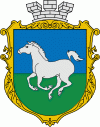Huliaipole (Hulyaypole)
 |
Prior to the annexation of the Crimean Khanate by the Russian Empire, the area was mostly settled by the Zaporozhian Cossacks and the nomadic Lesser Nogai Horde. The settlement arose during the 1770s, after the construction of the Dnieper defensive line on the former lands of the Zaporozhian Sich, as part of the Russian Empire's policy to populate and develop the conquered Zaporozhian lands. When Catherine the Great dissolved the Sich, the local Cossacks either fled into exile or were brought into serfdom, with the residents of what is now Huliaipole falling under the yoke of the Shabelskiys.
In 1785, the board of the Yekaterinoslav Governorate ordered the Novomoskovsk Zemstvo Court to establish the Huliaipole state military settlement for protection from the Crimean Khanate. Archival data confirmed that the first settlers came to the newly formed settlement from the territory of Starodubsky District, and later Kyiv region, Chernihiv region, Poltava region and Sloboda Ukraine. The name "Huliaipole" reflected the nature of the area where it was founded, which had frequently played host to fairs for a long time before the settlement's foundation. The settlement was traditionally divided into centuries, administrative-territorial units formed along military lines. Hundreds of people from Podolia, Pishchanka, Guryan, Verbiv, Bokhansky, Kherson and later Poland settled in this way. In 1794 the settlement had 150 yards. The inhabitants of the region were actively engaged in agriculture and animal husbandry.
In 1797 the wooden Orthodox Church "Exaltation of the Honest and Life-Giving Christ" was built, and Huliaipole became the township center of Alexandrovsky Uyezd.
Map - Huliaipole (Hulyaypole)
Map
Country - Ukraine
 |
 |
| Flag of Ukraine | |
During the Middle Ages, Ukraine was the site of early Slavic expansion and the area later became a key centre of East Slavic culture under the state of Kievan Rus', which emerged in the 9th century. The state eventually disintegrated into rival regional powers and was ultimately destroyed by the Mongol invasions of the 13th century. The area was then contested, divided, and ruled by a variety of external powers for the next 600 years, including the Polish–Lithuanian Commonwealth, the Austrian Empire, the Ottoman Empire, and the Tsardom of Russia. The Cossack Hetmanate emerged in central Ukraine in the 17th century, but was partitioned between Russia and Poland, and ultimately absorbed by the Russian Empire. Ukrainian nationalism developed, and following the Russian Revolution in 1917, the short-lived Ukrainian People's Republic was formed. The Bolsheviks consolidated control over much of the former empire and established the Ukrainian Soviet Socialist Republic, which became a constituent republic of the Soviet Union when it was formed in 1922. In the early 1930s, millions of Ukrainians died in the Holodomor, a man-made famine. During World War II, Ukraine was devastated by the German occupation.
Currency / Language
| ISO | Currency | Symbol | Significant figures |
|---|---|---|---|
| UAH | Ukrainian hryvnia | â‚´ | 2 |
| ISO | Language |
|---|---|
| HU | Hungarian language |
| PL | Polish language |
| RU | Russian language |
| UK | Ukrainian language |















